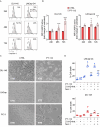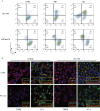Cancer cell-selective induction of mitochondrial stress and immunogenic cell death by PT-112 in human prostate cell lines
- PMID: 39394618
- PMCID: PMC11470694
- DOI: 10.1186/s12967-024-05739-x
Cancer cell-selective induction of mitochondrial stress and immunogenic cell death by PT-112 in human prostate cell lines
Abstract
PT-112 is a novel immunogenic cell death (ICD)-inducing small molecule currently under Phase 2 clinical development, including in metastatic castration-resistant prostate cancer (mCRPC), an immunologically cold and heterogeneous disease state in need of novel therapeutic approaches. PT-112 has been shown to cause ribosome biogenesis inhibition and organelle stress followed by ICD in cancer cells, culminating in anticancer immunity. In addition, clinical evidence of PT-112-driven immune effects has been observed in patient immunoprofiling. Given the unmet need for immune-based therapies in prostate cancer, along with a Phase I study (NCT#02266745) showing PT-112 activity in mCRPC patients, we investigated PT-112 effects in a panel of human prostate cancer cell lines. PT-112 demonstrated cancer cell selectivity, inhibiting cell growth and leading to cell death in prostate cancer cells without affecting the non-tumorigenic epithelial prostate cell line RWPE-1 at the concentrations tested. PT-112 also caused caspase-3 activation, as well as stress features in mitochondria including ROS generation, compromised membrane integrity, altered respiration, and morphological changes. Moreover, PT-112 induced damage-associated molecular pattern (DAMP) release, the first demonstration of ICD in human cancer cell lines, in addition to autophagy initiation across the panel. Taken together, PT-112 caused selective stress, growth inhibition and death in human prostate cancer cell lines. Our data provide additional insight into mitochondrial stress and ICD in response to PT-112. PT-112 anticancer immunogenicity could have clinical applications and is currently under investigation in a Phase 2 mCRPC study.
Keywords: Autophagy; Immunogenic cell death; Mitochondrial stress; PT-112; Prostate cancer.
© 2024. The Author(s).
Conflict of interest statement
C.Y. Yim, M. Congenie, T.D. Ames, M.R. Price and J. Jimeno are or have been employees of Promontory Therapeutics Inc.
Figures









References
-
- Siegel R, Miller K, Wagle N, Jemal A. Cancer statistics, 2023. CA Cancer J Clin. 2023;73:17–48. - PubMed
-
- Sung H, Ferlay J, Siegel R, Laversanne M, Soerjomataram I, Jemal A, Bray F. Global Cancer statistics 2020: GLOBOCAN estimates of incidence and Mortality Worldwide for 36 cancers in 185 countries. CA Cancer J Clin. 2021;71:209–49. - PubMed
-
- Buck S, Koolen S, Mathijssen R, de Wit R, van Soest R. Cross-resistance and drug sequence in prostate cancer. Drug Resist Update. 2021;56:100761. - PubMed
-
- Galletti G, Leach B, Lam L, Tagawa S. Mechanisms of resistance to systemic therapy in metastatic castration-resistant prostate cancer. Cancer Treat Rev. 2017;57:16–27. - PubMed
MeSH terms
Substances
Grants and funding
LinkOut - more resources
Full Text Sources
Medical
Research Materials

